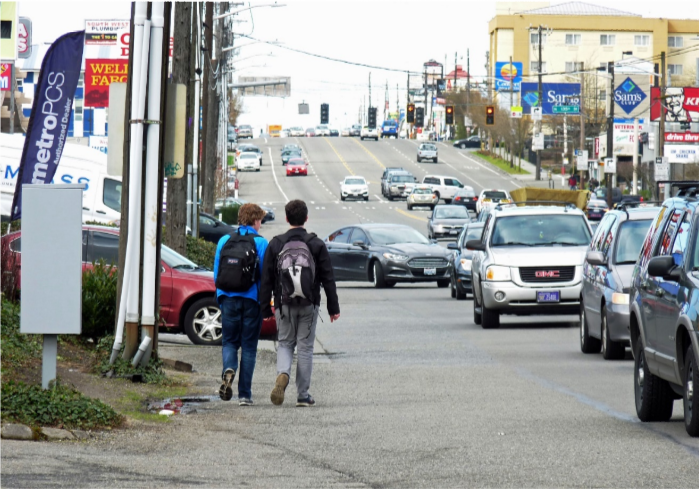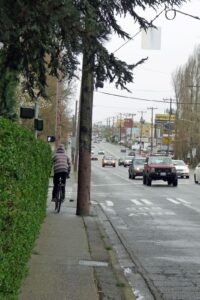This case study was written as part of our Dangerous by Design Technical Assistance program. This initiative brought together champions from across the country to advance street safety efforts through data collection and storytelling. This study was written by Natalie Lubsen from Transportation Choices Coalition.

There are too many news stories of people killed or injured on Aurora Avenue in Seattle, and most fail to tell the stories of the lives lost or forever altered. “A 73-year-old woman was hit and killed by a car while she was trying to cross Aurora Avenue North at Lynn Street.” “A driver heading up Aurora Avenue North hit a person crossing the street in a wheelchair, trapping the man underneath the vehicle on Wednesday evening.” These stories say very little about the people impacted or what will come after, but the violence they met with while trying to cross the street is clear.
Background
Frequently listed among the top ten most walkable cities, Seattle still grapples with challenges posed by major highways like Interstate 5 (I-5) and State Route 99 (SR-99, also called Aurora Ave N in North Seattle). These highways bisect neighborhoods and pose accessibility barriers and safety risks to people walking, biking, and rolling.
Aurora Avenue N is the deadliest street in Seattle. Also known as State Route 99, it’s a state highway that runs approximately 7.6 miles through North Seattle. It has between four and six lanes of traffic, wide lanes, and areas that lack sidewalks and safe and convenient crosswalks. It has speed limits of up to 40 mph, but recent speed studies show 17 percent of drivers exceed 55 mph. According to the Seattle Department of Transportation, “Aurora Avenue has a history of collisions, gaps in pedestrian facilities, inconsistent streetscape design, and accessibility barriers that make travel especially difficult for people with mobility challenges.”
“We urgently need to redesign and rebuild our Main Street Highways: state highways in population centers that are the most dangerous roads for pedestrians across Washington State. We should treat this like a megaproject, the same way we treat other highway projects. The coming legislative session is our opportunity to fund this work.”
-Kirk Hovenkotter, Executive Director at Transportation Choices Coalition
Taking Action
 The Seattle Department of Transportation is leading the Aurora Ave Project, a safety and mobility improvements study, with support from King County Metro. They conducted community outreach in 2022 and 2023 and released draft community ideas for public feedback in March 2024, which they will continue to evaluate as they move toward a design phase. In the meantime, SDOT is also working on several near-term safety projects. The current proposal for the Seattle Transportation Levy that will go to voters in November also includes $30 million for safety improvements along Aurora Ave N, $10 million of which is allocated to building new sidewalks.
The Seattle Department of Transportation is leading the Aurora Ave Project, a safety and mobility improvements study, with support from King County Metro. They conducted community outreach in 2022 and 2023 and released draft community ideas for public feedback in March 2024, which they will continue to evaluate as they move toward a design phase. In the meantime, SDOT is also working on several near-term safety projects. The current proposal for the Seattle Transportation Levy that will go to voters in November also includes $30 million for safety improvements along Aurora Ave N, $10 million of which is allocated to building new sidewalks.
At the state level, 2022’s Move Ahead Washington transportation package included $50 million for a demonstration project along 15 blocks of Aurora Ave N to make it safer and more accessible for people walking and biking. This funding has yet to be released, and it is currently threatened by a billionaire-funded ballot initiative, Initiative 2117, which would repeal the main funding source for Move Ahead Washington.
Many local groups are also committed to advancing pedestrian safety on the Aurora Ave corridor. The Aurora Reimagined Coalition brings together community groups, neighbors, the business community, and public agencies to create transformative change along the Aurora Ave corridor. Learn more about the coalition here.
A proposed series of short infographics from Transportation Choices Coalition will illustrate the state and city’s roles in fixing a dangerous corridor like Aurora Ave N. Transportation Choices Coalition will use these to win support for campaigns that can help make sure these efforts and the state and local investments are used to appropriately improve safety on this corridor. They will also leverage this work to win more safety investments in the next WA state transportation budget package.